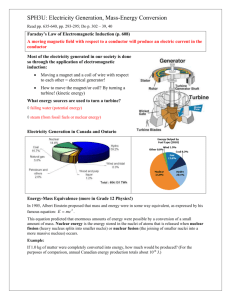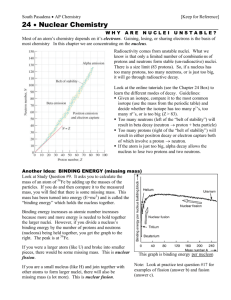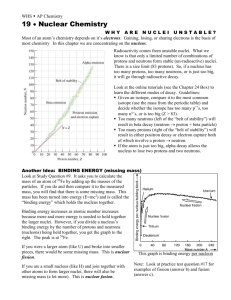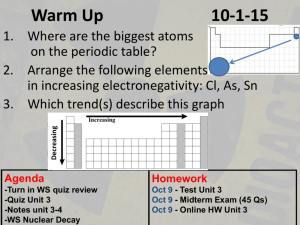Radioactivity
advertisement
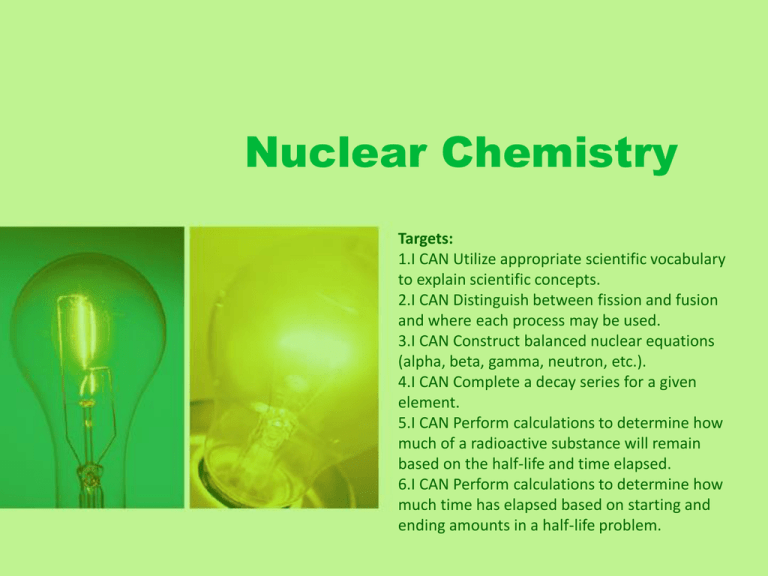
Nuclear Chemistry Targets: 1.I CAN Utilize appropriate scientific vocabulary to explain scientific concepts. 2.I CAN Distinguish between fission and fusion and where each process may be used. 3.I CAN Construct balanced nuclear equations (alpha, beta, gamma, neutron, etc.). 4.I CAN Complete a decay series for a given element. 5.I CAN Perform calculations to determine how much of a radioactive substance will remain based on the half-life and time elapsed. 6.I CAN Perform calculations to determine how much time has elapsed based on starting and ending amounts in a half-life problem. • Changes in matter originating in the nucleus of an atom • All atoms have• p+ and n0 (nucleons) • p+ number is the atomic number = Z • p+ + n0 = mass number = A The Nucleus • The nucleus is comprised of the two nucleons (a nuclear particle) protons and neutrons. • The number of protons is the atomic number. • The number of protons and neutrons together is the mass of the atom. • Nuclide, is the nucleus of an atom having a specific atomic number and atomic mass # Isotopes • Elements with the same atomic #, but different mass # due to gaining or losing of neutrons • Ex: There are three naturally occurring isotopes of uranium: – Uranium-234 – Uranium-235 – Uranium-238 Radioactivity • It is not uncommon for some nuclides of an element to be unstable, or radioactive. • We refer to these as radionuclides • Radionuclides are unstable and spontaneously emit particles and electromagnetic radiation (EM) • Radioisotopes- atoms containing these radionuclides • Transmutation- process by which one element is converted to another element by the spontaneous emission of radiation Large Nuclei • Nucleus is held together by strong force • Large nuclei tend to be unstable because the force is not strong enough to hold it together • These nuclei break apart and decay • All nuclei with 83 or more protons are radioactive • Almost all elements with more than 92 protons don’t exist naturally Neutron-Proton Ratios • Any element with more than one proton (i.e., anything but hydrogen) will have repulsions between the protons in the nucleus. • A strong nuclear force helps keep the nucleus together • Neutrons play a key role stabilizing the nucleus. • Therefore, the ratio of neutrons to protons is an important factor. Neutron-Proton Ratios For smaller nuclei (Z 20) stable nuclei have a neutron-to-proton ratio close to 1:1. Neutron-Proton Ratios As nuclei get larger, it takes a greater number of neutrons to stabilize the nucleus. Stable Nuclei • Nuclei above this belt have too many neutrons. • They tend to decay by emitting beta particles. Stable Nuclei • Nuclei below the belt have too many protons. • They tend to become more stable by positron emission or electron capture. What is Radioactivity? • When an unstable nucleus emits one or more particles or energy • When these particles are emitted, the element changes to another isotope or to a different element • Nuclear radiation refers to radiation resulting from nuclear changes Types of Nuclear Radiation • Alpha particles • Beta particles • Gamma rays Alpha Particles • Symbol is • Actually particles made of 2 p+ and 2 n0, same as a He nucleus • +2 charge, most massive of all nuclear radiation, mass = 4 amu • Do not travel far, can be stopped by a sheet of paper • Can be very dangerous inside human body – illness and disease Alpha Particle Emission Beta Particles • Symbol is Greek letter, beta (β) • High speed negatively charged particles that come from the nucleus – hmmm… • Neutron (neutral) actually decays to form a p+ and an e-, e- is ejected from nucleus • Travel farther than α, but can be stopped by 3 mm of Al, or 10 mm of wood • Can cause damage inside cells Beta Decay mk M Gamma rays • Gamma Radiation, γ • Not made of matter, no charge • Waves of electromagnetic energy (photons) • Usually emitted from nucleus when alpha or beta decay occurs • A nucleus de-excites by emitting a high energy gamma ray photon • High energy, can be stopped by 60 cm of Al or 7 cm of Pb • Cause less damage than alpha because it has no charge Gamma Radiation Damage Caused Penetrating Power Nuclear Decay • When unstable nuclei emit alpha or beta particles, what changes? – Number of protons or neutrons – New element or new atomic mass Change During Alpha Decay • Nucleus gives up 2 p+ and 2 n0 • All mass numbers add up, all atomic numbers add up Change During Beta Decay • Neutron is changed to a proton and an electron and emitted • Increases atomic number due to conversion of a neutron to a proton and an electron • So neutron is lost and proton is gained Gamma Emission Loss of a -ray (high-energy radiation that almost always accompanies the loss of a nuclear particle) 0 0 238 U 92 → 238 Th 90 + 4He 2 + 0 (gamma ray) Classwork/Homework • WS with example problems Decay Rates • Half-life = the time in which half a radioactive substance decays • After 1 half-life, half of the substance is unchanged • After 2 half-lives, ¼ of the substance is unchanged • Half-life table on p. 226 Half-Life • Measure how quickly a substance decays • Can be anywhere between nanoseconds to billions of years, depending on nuclear stability • C-14 is used to find the age of relatively recent materials • C-14 is taken in in tiny fractions while alive in some molecules of CO2 • C-14 goes through beta decay, so ratio is compared in living and nonliving things Half-Life Example • The half-life of iodine-131 is 8 days. • If you start with 36 grams of I-131, how much will be left after 24 days? • 36 g 1 half-life 8 days 18 g • 18 g 2 half-lives 16 days 9 g • 9 g 3 half-lives 24 days 4.5 g Classwork/Homework • WS – Nuclear Decay • Half-Life problems on the back


